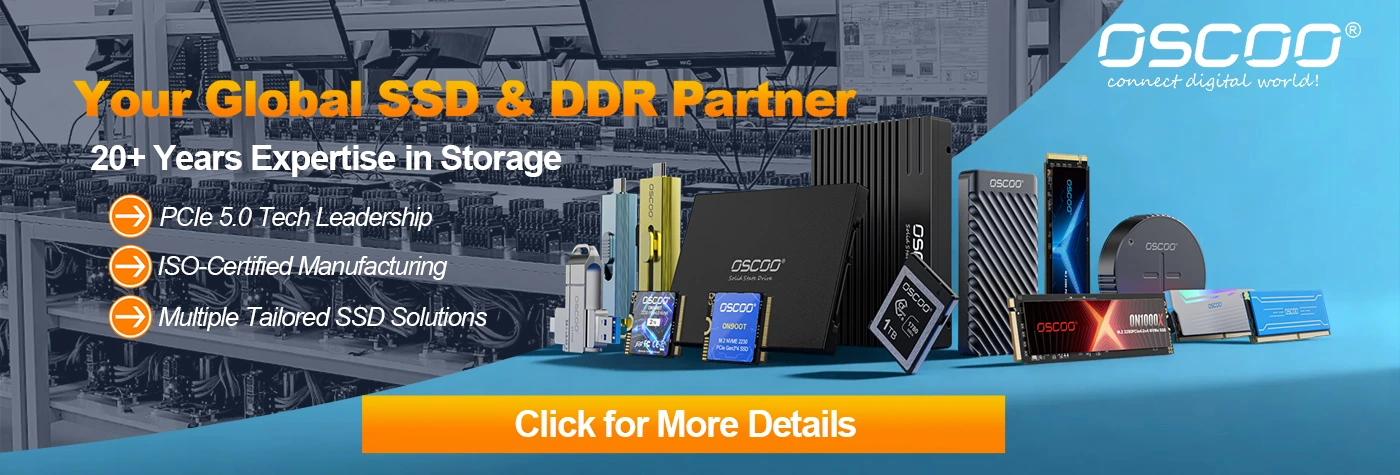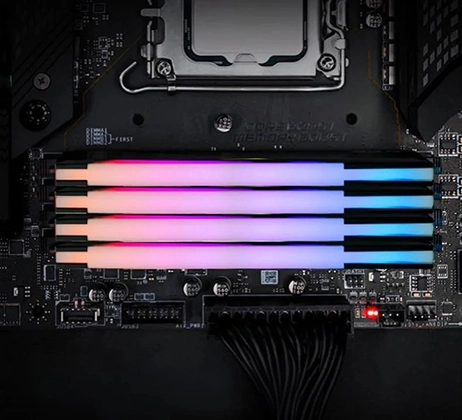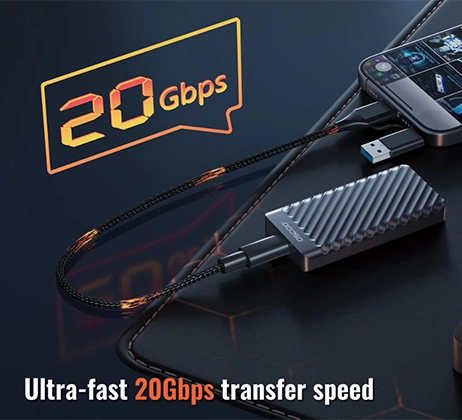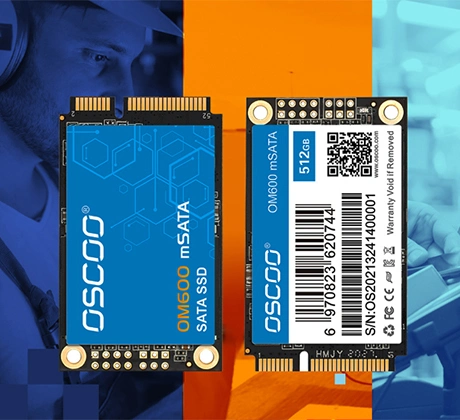When you need to expand your computer’s storage space or want to back up precious photos and videos from your phone, a reliable external storage device becomes essential. Faced with the choice between traditional external hard drives and newer external solid-state drives on the market, many people feel confused: What exactly is the difference? Which one is better for me? This article will take you deep into the various aspects of external hard drives versus external solid-state drives. Through clear comparisons, it will help you make the smartest choice based on your own needs and budget.

A Simple Understanding of How They Work
The most fundamental difference between external HDDs and external SSDs lies in their internal data storage methods, which determine almost all their characteristics. We can understand this with a simple analogy: an external HDD is like an old-fashioned vinyl record player, while an external SSD is like a large, high-speed USB flash drive.
An external HDD, or Hard Disk Drive, has a precise mechanical world inside. It contains high-speed spinning magnetic platters and a read/write head that moves across these platters. When you need to access data, the head must physically move to the correct position on the platter. This entire process involves mechanical movement. This way of working is similar to a record player from decades ago, where the tonearm needs to move to specific grooves on the record to play music.
In contrast, an external SSD, or Solid State Drive, has no moving parts inside. It relies entirely on semiconductor technology, with data stored in flash memory chips. When you access data, an electrical current directly addresses the specific memory cells through circuits. The entire process is electronic, with no mechanical delays. This is the fundamental reason why SSDs can far surpass HDDs in speed. Understanding this core difference allows us to better interpret the different characteristics they exhibit in the following comparisons.
Comprehensive Comparison: External HDD vs SSD
After understanding their completely different working principles, we can delve deeper into the specific impacts these fundamental differences bring in practical use. It is the core distinction between mechanical movement and electronic transmission that makes them exhibit completely different characteristics in key dimensions such as speed, durability, and price. The detailed comparison below will help you clearly see which type of device better suits your specific needs and usage scenarios.
السرعة
In terms of speed, the gap between external SSDs and external HDDs is most obvious, almost like night and day. The speed of an external HDD is limited by physical mechanical movement. When reading or writing data, the platter needs to spin to the correct position, and the actuator arm needs to move to find the data track. This process inevitably causes delays. Currently, mainstream external HDDs typically have read/write speeds ranging from about 80 MB/s to 160 MB/s. This means transferring a 20GB video file might take two minutes or longer.
Because external SSDs have no mechanical parts, data is accessed directly in the flash memory chips via electronic signals. Their speed bottleneck lies mainly in the controller and interface. Even basic external SSDs using the SATA protocol can easily achieve speeds of over 500 MB/s. More advanced external SSDs supporting the NVMe protocol can even break through 1000 MB/s, or 1 GB/s. Transferring the same 20GB file could take less than 20 seconds at its fastest. It’s important to note that to fully utilize an SSD’s performance, your computer must also provide corresponding high-speed interface support, such as USB 3.2 Gen 2 or Thunderbolt.
Capacity and Price
In terms of storage capacity and product price, external HDDs still hold an absolute advantage. External HDDs are known for their huge capacities and low prices. In the consumer market, capacities from 1TB to 5TB are very common, and models aimed at professional backup needs can even have capacities as high as 20TB or more. More importantly, their prices are very affordable. This allows users to easily obtain massive storage space with a relatively small budget, making them very suitable for backing up an entire computer system, years of accumulated photo and video libraries, or storing documents and data that are not used often but cannot be discarded.
In contrast, while the capacity of external SSDs is also continuously growing, mainstream products are still concentrated in the range of 500GB to 2TB. Products with 4TB or larger capacities do exist, but their prices become very expensive, often several times or even ten times the price of an HDD of the same capacity. This means that for users with a limited budget who need massive storage space, external HDDs are the only realistic choice.
Durability and Shock Resistance
In terms of durability, external SSDs have an inherent advantage due to their solid-state structure. Because there are no moving parts inside, they have a very strong tolerance for shocks and bumps. Whether it’s the jostling of a daily commute or an accidental slip from a desk during use, it usually won’t affect their normal operation, thus better ensuring data security. Many external SSDs are also equipped with sturdy metal casings or rubber sleeves and have high dust and water resistance ratings, further enhancing their reliability in various environments.
In comparison, the mechanical structure of an external HDD is its main weakness in terms of durability. When it is working, the distance between the read/write head and the high-speed spinning platter is extremely small. If the device suffers a significant shock or impact, such as being accidentally dropped while moving, the head can easily collide with the platter, causing platter scratches or even mechanical structural damage, leading to data loss. Therefore, external HDDs are especially fragile when operating and must be placed on a stable surface and carefully protected from any bumps.
This difference makes external SSDs a better choice for users who often need to carry the device outdoors, while external HDDs are more suitable for being fixed in one location as static backup storage devices. However, it’s important to note that if the storage chips or controller of an SSD itself experience electronic failure, the difficulty and cost of data recovery are usually much higher than recovering data from an HDD with mechanical damage. Regardless, regularly backing up important data to multiple different locations is the most effective way to ensure data security.
Physical Characteristics
Physical characteristics directly affect the portability and user experience of the device. In this aspect, the advantages of external SSDs are very obvious. The most intuitive feeling comes from size and weight. Because they don’t need to accommodate platters and complex mechanical structures, external SSDs can be made very small and lightweight. Many models are only slightly larger than a business card, and as thick as a stack of a few coins, easily fitting into a pocket or a small bag, adding almost no noticeable extra weight. In contrast, external HDDs, because they contain metal platters and a drive motor inside, are usually larger, thicker, and significantly heavier, feeling more cumbersome to carry.
Another key difference is noise. External SSDs are completely silent when working because data access is done silently via electronic signals. When an external HDD reads or writes data, you can clearly hear the buzzing sound of the high-speed spinning platters and the “clicking” sound of the head moving quickly. In a quiet environment, this sound might be disturbing to some users.
Furthermore, power consumption and heat generation are physical characteristics that cannot be ignored. External SSDs typically have lower power consumption, which is particularly important for use with laptops on the go, helping to extend the device’s battery life. At the same time, their heat generation is relatively small. External HDDs, because they need to drive a motor to spin, have higher power consumption and generate more heat. After long periods of continuous operation, you can clearly feel the rise in case temperature when touched.
Lifespan and Data Security
Regarding lifespan, a common misconception is that SSDs are not durable, but this needs to be viewed more comprehensively. The lifespan of an external SSD is usually measured by “Total Bytes Written” (TBW), meaning its lifespan is mainly affected by frequently erasing and writing data. For the vast majority of ordinary users, it’s almost impossible to reach its theoretical write limit in daily use. Normal use for five years or even longer is completely fine. In comparison, the mechanical structure of an external HDD has a long lifespan, but its mechanical components like the motor and bearings wear out over time. Its failure mode is often sudden and unpredictable; it might “fail” without warning after an accidental impact or after tens of thousands of hours of operation.
This leads to the core issue of data security and recovery. If the physical structure of an external HDD is intact, and only the circuit board is damaged or there are logical bad sectors, professional data recovery services have a relatively high success rate, and the technology is very mature. However, its biggest risk comes precisely from the fragility of its physical structure; platter scratches can lead to permanent data loss. External SSDs are the opposite; their sturdy physical characteristics make them less prone to damage from shocks and falls, protecting data better at the physical level. But once the main controller chip or the storage chips themselves experience electronic failure, data recovery becomes extremely difficult and costly.
| Comparison Aspect | External HDD | محرك أقراص SSD خارجي | Key Takeaway |
|---|---|---|---|
| السرعة | Relatively slow, typically 80-160 MB/s, limited by mechanical seek time. | Extremely fast, typically 500 MB/s to over 2000 MB/s, with almost no delay. | SSD wins decisively, significantly improving work efficiency. |
| السعة | Very large capacity, common consumer models range from 1TB to 5TB, with high-end models exceeding 20TB. | Relatively smaller capacity, mainstream products are 500GB to 2TB; models above 4TB are scarce and expensive. | HDD has the advantage, suitable for massive data storage. |
| Price | Low price, very low cost per GB, the best choice when seeking large capacity on a budget. | Expensive, cost per GB is much higher than HDD, a premium paid for speed and portability. | HDD offers excellent value for money. |
| Durability | Very sensitive to shocks and bumps; drops during movement can easily cause mechanical failure and data loss. | Very robust and durable, shock and drop-resistant, well-suited for mobile use cases. | SSD is more reliable, offering higher physical data security. |
| الضوضاء | Audible noise and vibration from spinning platters and moving read/write heads during operation. | Completely silent, produces no noise during operation. | SSD has the advantage, suitable for quiet environments. |
| Size & Weight | Generally larger, thicker, and heavier, resulting in average portability. | Compact and lightweight design, easy to carry. | SSD is superior, excellent portability. |
| استعادة البيانات | If mechanical failure occurs but platters are undamaged, data recovery success rate is relatively higher. | If the memory chips or controller fail electronically, data recovery is extremely difficult. | HDD has a slight advantage, but neither is absolutely reliable. |
| Lifespan | Mechanical parts may fail suddenly due to wear or impact; end-of-life is often unpredictable. | Lifespan is determined by write cycles (TBW); sufficient for many years of normal use for average users; lifespan is more predictable. | Different characteristics; SSD’s lifespan pattern is more predictable. |
Pros, Cons, and Application Scenarios
After the detailed comparison, we can clearly summarize the respective advantages and disadvantages of external SSDs and external HDDs, and based on this, clarify their most suitable application scenarios.
Pros and Cons of External SSD
The main advantages of external SSDs focus on excellent performance and reliability. It has extremely fast read/write speeds, which can significantly save time on file transfers and program loading. Because there are no mechanical parts inside, it has strong resistance to shocks and drops, offering high physical data security. At the same time, it is small, lightweight, completely silent during operation, and generates less heat, providing a very comfortable user experience.
However, the disadvantages of external SSDs are also obvious. The most prominent is its high price; for the same capacity, the cost of an SSD is much higher than that of an HDD. Also, the maximum single-drive capacity of mainstream SSD products on the market is currently relatively low. For users who need to store tens of terabytes of data, the options are limited and the total cost would be very high. Furthermore, if the storage chips or controller of an SSD suffer electronic failure, data recovery is very difficult and costly.
When to Choose an External SSD?
- Engaged in creative or professional work: If you are a video editor, photographer, programmer, or designer and need to frequently read/write large project files, the speed of an SSD can greatly improve your work efficiency.
- Gamers seeking the ultimate experience: Want to run large games directly from an external drive to reduce loading times and get a smoother gaming experience.
- Students or office workers who are frequently mobile: Need to carry a lot of materials with them; the portability and shock resistance of an SSD better protect data security and adapt to various mobile scenarios.
- Users sensitive to noise: Using in quiet environments like libraries or meeting rooms, the complete silence of an SSD is crucial.
Simply put, when you need to trade money for time, efficiency, and portability, an external SSD is the ideal choice.
Pros and Cons of External HDD
The advantages of external HDDs lie in their unparalleled storage capacity and high cost-effectiveness. They can provide massive storage space up to several terabytes or even tens of terabytes at a very low cost, making them very suitable for storing vast amounts of cold data. Additionally, if the device experiences a logical failure rather than severe physical damage, data recovery techniques are relatively mature and have a higher success rate.
However, the disadvantages of external HDDs stem from their mechanical structure. Their read/write speeds are slow, becoming a bottleneck when handling large files or running programs. They are very afraid of shocks and impacts; accidental drops during movement or use can easily lead to data loss. At the same time, they generate noise and vibration during operation, and their size and weight are usually larger than SSDs, resulting in poorer portability.
When to Choose an External HDD?
- Need for large-scale data backup: If you need to perform regular, massive backups of family photos, video libraries, music collections, or entire computer systems, the large capacity and low cost of HDDs are irreplaceable.
- Limited budget but need large space: For students or users on a tight budget who want to get the most storage space for the least amount of money, used for storing documents, software installation packages, and other infrequently accessed data.
- Fixed usage scenario, no need for frequent movement: For example, as a fixed backup drive for a desktop computer, or as an expansion drive for a home network storage device, where its vulnerability to shock has less impact.
- Archival storage with low speed requirements: Storing historical project files, archives, etc., that need to be kept long-term but are rarely accessed.
In summary, when your core need is to store the largest amount of data at the lowest cost, and you don’t have high requirements for transfer speed and portability, external HDDs are still the most cost-effective solution.
In the choice of external storage, there is no single perfect answer that suits everyone. External HDDs and external SSDs are two types of products born for different needs; their strengths and weaknesses complement each other. The key to making a choice is to clearly examine your own core requirements. If you prioritize ultimate transfer speed, device sturdiness, portability, and quiet operation, and your budget is relatively sufficient, then an external SSD is your best partner for improving efficiency and experience. Conversely, if your primary task is to store massive amounts of data at the lowest cost for backup or archiving, and you don’t have high speed requirements, then an external HDD is undoubtedly a more cost-effective and reliable choice.





